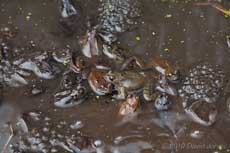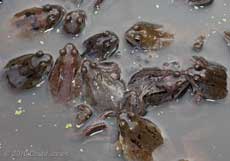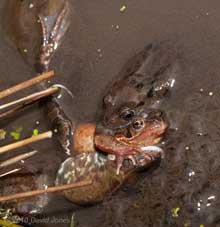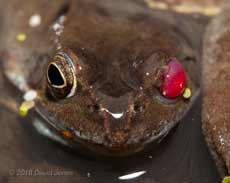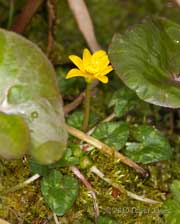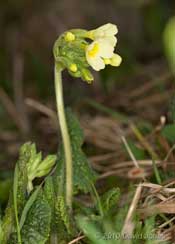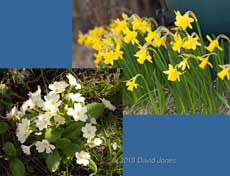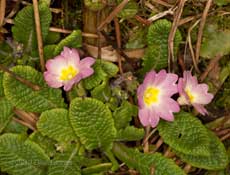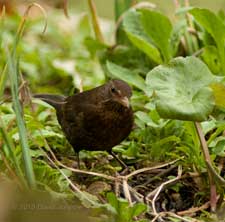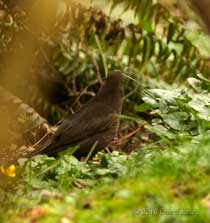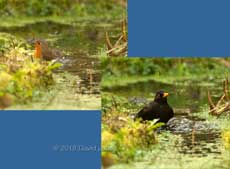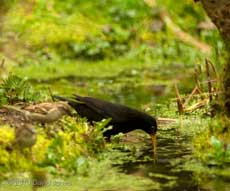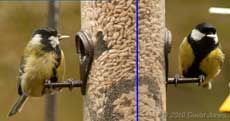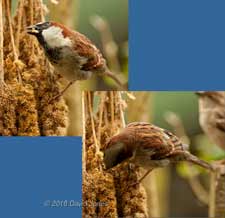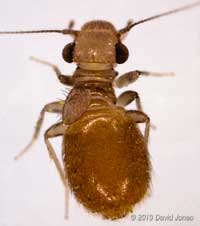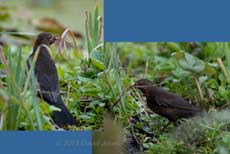Go to the last entry on this page .....Go to previous entry18 March - A bright morning, but with cloud cover moving in the afternoon was disappointing. I spent much of the day outside as I assembled nest boxes, and as I packed up around 5pm there was just a touch of dampness in the air. During the morning I would readily have exchanged my drill for my microphone when a Coal Tit arrived to feed and was enthusiastically vocal.
Before I started work I spent a bit of time with the frogs again. Numbers don't seem to have increased, although with the shallow end of the pond now looking like soup and with the frogs in constant motion it is difficult to count them.
As far as I could tell there were only a couple new clumps of spawn this morning and for most of the frogs it seemed a case of waiting for action to start elsewhere.
The only example of amplexus that I could see this morning was this group of just three, with others coming and going without real interest.
The colours and pattern exhibited by the frogs varies a great deal, but this individual stood out from the crowd for the wrong reason. Apart from the injured eye it seemed to behave normally. I shall have to watch out for it over the next few days.
While most of the frogs in the big pond spent the morning in the shallow end, it was noticeable how they all headed for deeper water as the afternoon turned dull, and colder.
21 March - The last two days were wet, and while they were rather miserable from my point of view, the ponds definitely welcomed the water! Today was much better, with sunny periods that I was able to take advantage of to get the new nestboxes painted. I was a bit surprised that the pond was quiet despite the sunshine. It seems that spawning may be over. I didn't take any photographs of the frogs and spawn today, but I hope to record the spawn tomorrow. The quantity looks rather down on previous years. There were a couple of first flowerings to record today.
First was this Lesser Celandine, growing in a marshy area of the big pond amongst the developing leaves of a Marsh Marigold. There is a lot of Lesser Celandine foliage developing around the pond and along the border, but there is no sign of further flowers opening yet.
The second new flowering was of the Cowslip, next to the big pond.
The Daffodils and early Primroses are doing very well now, and it's worth noting that very few of the flowers are suffering the attention of slugs, thanks, I assume, to the cold winter.
It seems that the local male Blackbird has decided that it is time to sing, although it is at least a couple of gardens away from us so perhaps he and his partner have found a good spot away from our garden this Spring. There is still a Song Thrush in the area, although he is quite a bit further away than the Blackbird. The male Robin, on the other hand does much of his singing from our Birch tree. My monitoring of the barkfly came to an end today after a fascinating few weeks. I shall have to get back to searching for them and other insects in our garden once again. A quick check of the shrubs today failed to reveal any barkflies, although I did find a couple of nymphs on a bamboo leaf.
24 March - What was forecast to be cloudy and at least damp turned into a mainly sunny day, bright enough to bring out a Brimstone butterfly that I spotted fluttering around the bamboo plants. Shortly afterwards I disturbed another butterfly that must have been sunbathing on the path past the ponds. I only caught a glimpse of that one, but it may have been a Comma. Their appearances are a week later than in 2009. Despite the sunshine the pond was quiet today, confirming that spawning is really over. The good weather gave me the opportunity to put up the third nestbox, but I'm afraid that after that was done I 'ran out of steam', so couldn't spend the time that I should have in the garden. The forecast suggests that we will have to wait a few days before another sunny day arrives.
26 March - A day of showers and some sunshine.
Another one of our 'indicator plants' came into flower yesterday, this pink Primrose that comes up each year at the far end of the bog pond. Over the previous three years it came into flower on the 6th, 15th and 10th. This Spring it is at least two weeks later.
A glance out of the bedroom window provided some good news this morning - a female Blackbird was struggling to get a grip on a piece of the paper-thin bark that peels off our Himalayan Birch tree. Once she had it firmly in her beak she headed into the Ivy tree, confirming that the Blackbirds have now joined the Robins in nesting in there.
I certainly saw a lot more of both female and male Blackbirds in the garden today. This was the female foraging for a meal in the middle of the day.
At the end of that task she picked up a single, rather flimsy length of dried grass from beyond the big pond and took it up into the Ivy tree. I shall have to watch for her gathering moss during the weekend.
In the meantime, her partner was making himself heard from various high spots beyond the end of the garden, taking the occasional break to feed and bathe in a favoured spot at the side of the big pond, arriving just after the Robin had completed its ablutions.
This is also a spot where birds come to drink, preferred over the (usually) clean water in the bird bath!
I don't think they ever arrive to feed without the partner, although they usually approach the feeders one at a time, taking the food back into the Hawthorn to actually eat it.
Back when we had snow I hung up a cluster of millet seed heads and they were ignored, despite the contents of their feeder also being millet. For some reason (the feeder is full of the 'usual' mix), over the last three days the Sparrows have finally found them.
Now a bit of catching up, which should perhaps be in the nest box diary. I have finally got to take a photograph of the barkfly that I found in the Swift box used by the Sparrows. Unfortunately it has lost one of its rudimentary wings. I failed to get a side view, but in this picture you can see a dark band between the right eye and the antenna. The presence of this line indicates that it is Lepinotus patruelis, a species normally found in domestic environments (although I have never come across one inside our house, apart from the couple that I've brought inside to identify).
28 March - A day which started bright and mainly sunny but which turned cloudy and damp later.
Just a couple of observations today - First, the female Blackbird continues to work on her nest in the Ivy tree, collecting materials from between the ponds this morning.
And the sap is not only rising for the Blackbirds - on my way down to the bottom of the garden at around noon I noticed that there was a wet patch on the path to the Great Tit nest box. As it hadn't been raining this morning I was a bit puzzled. As I stood there I realised that there was a constant drip from above. about seven feet up was a rather wet bamboo leaf, but that was not the source. The drip turned out to be coming from a branch high up in the Birch tree. The liquid had to be sap escaping from the tree, so in order to taste it I left a glass dish on the ground for a couple of hours, and I now have about 25ml of Birch sap in my fridge! It seems that although I haven't come across it here before this is a common occurrence in Birch trees. They are actually tapped for sap in some countries, mainly Northern Europe and Asia where it is a traditional beverage, and drunk as a tonic! My small sample had very little taste. Sap is only tapped in the early Spring before the tree's leaves start to open.
Click on images to see larger version |
|
